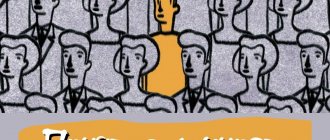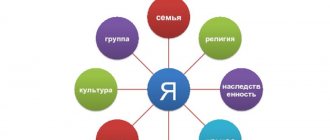There comes a time in life when you feel ready to move to the next level and begin to look for suitable ways to develop your personality. You feel that the lessons of the past have served you well, they have made you stronger and wiser.
And even if things are going well in life, you still want to take the next step. Whether it's a career or your personal growth, eventually you would like to move beyond your current limitations.
So, let's assume that you have decided to move to the next level of development, one question remains: how to do it?
In this article, we will offer you eight amazing strategies to help you take a step forward and look at the conditions and ways of personal development.
But first, let's figure out why we need to develop, set goals and achieve them?
Introduction
It is difficult to overestimate the importance of the topic of personality development, which is the subject of this work. Nowadays, the process of robotization of industry is proceeding at a rapid pace, which is being introduced into everyday life, trying to replace human activity in all spheres of its existence. Experts in the field of artificial intelligence, crossing living things with non-living things, are trying to prove that such crossing will lead to new forms of life, although everyone knows that if you attach a crutch to a person, it will not make him any smarter. On the contrary, his sphere of freedom becomes limited, which has a depressing effect on his psyche. It is enough to remember the name given to robots by the Strugatsky brothers in their novel “Snail on the Mountainside” - undead - to understand: any introduction of non-living things into living things leads to its death.
Nevertheless, the process of automation and robotization can only be welcomed if it is put at the service of man, and not at his destruction. And the fact that with the development of robotization a person’s free time is freed up can only be welcomed if we teach a person to use his time effectively, and not somehow. Those. induce in him a desire to develop his abilities, in particular creative abilities.
In this regard, this work examines some methods of personality development, in particular, in the aspect of social psychology. First, the subject of social psychology is defined, the concept of personality, the concept of personality development, research methods in social psychology and, finally, methods of personality development. The concept of groups, large and small, and their influence on personal development are also noted.
The object of research is personality and methods of social psychology.
The subject is the study of methods of personality development.
The purpose of the work is to analyze methods of personality development.
Tasks
1) Analyze methods of personality development
2) Study methods of personality development
Structure of the work: The course work consists of an introduction, main part, conclusion and a list of sources used.
Methods of personality formation
□ The situation of creativity (V.A. Karakovsky) is to create conditions for the development of schoolchildren’s creative abilities, their imagination, fantasy, ability to improvise, ability to get out of a non-standard situation, etc.
□ The situation of competition (A. N. Lutoshkin) evokes the desire to be better, as well as the corresponding volitional effort and, as a result, the achievement of better performance. This is usually confirmed by official recognition: a prize, number of points, diploma, diploma, etc. Competition is a method of stimulating the activity of students by creating conditions in which each participant strives to demonstrate their abilities to the maximum and achieve better results compared to other participants. Competition contributes to the formation of the qualities of a competitive personality. This method is based on the child’s natural inclinations towards leadership and competition. The effectiveness of competition increases when students' activities are saturated with situations of experiencing success.
Traditional methods of stimulating activity and behavior are methods of reward and punishment. Encouragement is a way of expressing a positive assessment of the actions of students, public recognition of the course of action that is chosen and implemented by the student in practice. Encouragement reinforces positive habits and behavioral skills, arouses positive emotions, and instills confidence in one’s own abilities. Forms of encouragement: approval, praise, gratitude, granting honorary rights, rewarding and others. Despite its apparent simplicity, this method requires careful use. Encouragement should evaluate not so much the result as the motive and method of activity. The student should not be taught to expect reward for the slightest success. It is important that encouragement is a natural consequence of the student’s action, and not a consequence of his desire to receive encouragement. Particularly in need of encouragement are timid, insecure students, as well as those who are especially sensitive to the assessment of their actions and behavior in general. The attitude towards punishment as a method of education in pedagogy is ambiguous and contradictory. Punishment is an impact on a person that expresses condemnation of actions and deeds that are contrary to the norms of social behavior and forces students to strictly follow them. Punishment corrects the child’s behavior, makes him understand where and what he did wrong, causes a feeling of guilt towards himself and others, a feeling of shame, discomfort, and dissatisfaction with himself. This condition may develop into a need to change one's behavior. Such types of punishment as the imposition of additional duties, deprivation or restriction of certain rights, censure, condemnation are known. In any case, the punishment must be fair, understood by the student (analysis of the causes and conditions that led to the offense), and must not humiliate his dignity or cause him moral or physical suffering.
Types of education
Education is a purposeful and organized process of personality formation; it is the transfer of accumulated experience from older generations to younger ones. Experience is understood as knowledge, skills, ways of thinking, moral, ethical, legal norms known to people - in a word, all the spiritual heritage of humanity created in the process of historical development.
Types of education:
— Mental education is the mental, moral, emotional and physical development of the individual, the disclosure of his creative potential. Conscious assimilation of a knowledge system contributes to the development of logical thinking, memory, attention, imagination, mental abilities, inclinations and talents.
— Physical education is an integral part of almost all educational systems. Physical education contributes to the development in young people of the qualities necessary for successful mental and labor activity.
— Labor education — covers those aspects of the educational process where labor actions are formed, production relations are formed, tools of labor and methods of their use are studied. Labor in the process of education also acts as a leading factor in personal development.
— Polytechnic education is aimed at familiarizing with the basic principles of all industries, acquiring knowledge about modern production processes and relationships. The main tasks of polytechnic education are the formation of interest in production activities, the development of technical abilities, new economic thinking, ingenuity, and the beginnings of entrepreneurship.
— Moral education — forms moral concepts, judgments, feelings and beliefs, skills and habits of behavior that correspond to the norms of society. The moral education of the younger generation is based on both universal human values, enduring moral norms developed by people in the process of historical development of society, and new principles and norms that have arisen at the present stage of development of society.
— Aesthetic education is a basic component of the goals of education and the educational system, summarizing the development of aesthetic ideals, needs and tastes among students. The tasks of aesthetic education can be conditionally divided into two groups - the acquisition of theoretical knowledge and the formation of practical skills. The first group of tasks solves the issues of familiarization with aesthetic values, and the second - active inclusion in aesthetic activities.
Principles of training
The principles of teaching are the conditions on the basis of which the teaching activity of the teacher and the cognitive activity of the student are built.
The development of teaching principles began several centuries ago. For the first time, teacher Jan Komensky spoke and tried to formulate the principles of teaching. In his work “The Great Didactics,” he called them the fundamental principles on which the entire pedagogical process should be built.
K. D. Ushinsky played an invaluable role in the development of teaching principles.
— The principle of consciousness and activity. This principle reflects the need to develop motivation for learning and stimulate learning activities.
— The principle of visualization has been popular since ancient times and is quite effective, being intuitive. Using visual material where possible, the teacher opens up another channel of perception for students - the visual, which significantly increases the efficiency of learning.
— The principle of systematicity and consistency gives a systematic character to the learning process, which is a necessary condition for the effectiveness of any impact. The skills and abilities already acquired by a person in the learning process must be systematically applied in real or artificially created conditions, otherwise they begin to weaken
— The principle of strength. The goal of this principle is the strong and long-term assimilation of the acquired knowledge. This goal is achieved by developing the student’s interest and positive attitude towards the discipline being studied. To do this, the teacher must strive to establish positive emotional contact with students.
— The principle of accessibility implies the development of the content of the learning process taking into account the capabilities of students. An important condition for accessibility is the correct sequence of presentation of educational material. To learn new information, the student must have appropriate basic knowledge. It is necessary to correlate the complexity and volume of new knowledge with the age of students and their individual characteristics, such as health, learning ability, and psychophysical state.
— The scientific principle consists in the careful selection of information that makes up the content of training, meeting the following requirements: students should be offered to master only firmly established, scientifically based knowledge, methods of presenting this knowledge should correspond to a specific scientific field.
— The principle of connection between theory and practice is based on the central concept of philosophy: practice is the main material for knowledge. Practical activity plays an undeniably large role in pedagogical science. Practical knowledge obtained is the most reliable source of information.
⇐ Previous7
Recommended pages:
Essay
The object of research is the individual. The subject of the research is personality development. The purpose of the course work is to study methods of personality development. The research method is analysis of personality development.
In the modern world, personality development practically does not play any role in a person’s life. People are used to living that life, the thoughts and actions with which they lived; they don’t want to change anything in themselves and don’t even try. This is due to the fact that new technologies have appeared in their lives, which dull their brains and prevent them from developing normally. People degrade without having time to know anything.
A person must get to know himself every day, develop his personality, be an individual, have his own opinion, regardless of the situation, time and place, no matter how trite it may sound, but a person must read books for self-development, watch films, listen to music.
The problem of personal development in the modern world is that people absolutely do not care about themselves and how they live. Personal development is not a relevant topic for them.
How to develop a personality and become a gray mass? Methods of development can be different - genetic, sociogenetic orientations, personogenetic orientations.
What can influence personality development? There are many factors that can hinder personal development, but the main ones, in my opinion, are: mental and emotional imbalance, aggressiveness, isolation, indecision, lack of inclination to work with people, inability to understand the position of another person, rigidity of communication, low intellectual level, a blank slate.
Application of NLP: examples
One of the classic examples that helps explain the meaning of reframing is a drawing with three fish. One of them - the smallest one - escapes from the pursuit of the middle one. While the average fish, keen on hunting the small one, does not notice the direct danger to its own life.
The first of the drawings has no meaning. It simply depicts two fish - the predator and the hunted. They can symbolize anything: maybe a woman trying to lose weight, or a company manager who dreams of beating competitors and taking a high position. Or maybe these fish symbolize the desire of a common person to get rid of communication with an annoying relative. In all cases, there is a concentration of attention on a strictly defined goal. Rice. 1. Narrow frame
Rice. 2. A broader view of the world
In the second picture the situation is no longer so clear. The fish in the middle can realize other pressing problems of its existence. In addition to being obsessed with losing weight, the woman discovers that she should pay more attention to paying off her loan debts. A manager seeking a promotion should pay attention to the emotional coldness of his wife, who has been plotting a divorce strategy for three months now.
Reframing can be used in both images and words. There are thousands of phrases that, despite their harmlessness, carry critical overtones. For example, the expression “avoid stress” contains an undesirable meaning. It is better to replace it with the word “relax.” Many words are carefully disguised as positivity. For example, the expression “I want to avoid unnecessary expenses.” What's wrong, on the one hand, with this phrase? On the other hand, it is expressed in negative word forms and carries negativism. It is better to replace it with a more life-affirming one: “I want to make sure that I stay within my budget.”
Reframing is a great tool for self-reflection. It is especially useful to pay attention to the phrases with which we think. By changing your thinking, you can have a serious impact on the events in your life.
Three paths to personal growth
And if the question of personal growth arises at all, it means that there is no harmony in your life and some changes are needed.
You can start practicing self-development at any age, at 20, 30, 40, and 50 years old. You can always engage in self-development!
Personal growth or self-development is the process of developing some new qualities in yourself that will lead you to improvement in many areas of life.
In 1959, the famous psychologist Karl Rogers indicated that personal growth must begin if you want fundamental changes in life and he highlighted
The law of “personal growth”, which fits into one phrase: “If..., Then...”.
For example, if I don't know how to swim, then I will drown if I don't take some action.
OR
If I learn to swim, then I will swim in any situation.
There are different methods, let's look at which ones.
- From the books
- Develop your own method of personal growth
- With the help of a coach (the most expensive and fastest way)
And a mixed path, when you little by little try what is closer to you, how better and faster you can achieve your goals.
Humanistic education system
Modern pedagogy proclaims the conscious participation of children in their development as a condition for effective education. The object of education becomes a subject. The child’s own activity becomes one of the factors in the process; the teacher only helps and guides, giving the student the opportunity to make independent choices, while simultaneously promoting his individual development.
The humanistic system presupposes an attentive, respectful attitude towards children, tolerance for their opinions, and concern for psychological comfort. It is necessary for young people to feel needed and protected.
Parents and teachers must rely on national and cultural traditions, take into account the age, level of development of students, their habits, gender, and natural characteristics.
Modern approaches
The methods of education today dictate several ways of approaching it.
System
Interprets the emerging personality as a holistic entity. The goals, content and organization of educational activities are maximally interconnected. The systematic approach provides a number of conditions for self-realization, creativity, and individuality development.
How to raise a child with personality
Activity-relational
The pupil is encouraged to engage in various activities that contribute to the acquisition of social experience. The developmental influence of this approach manifests itself only if it evokes internal experiences in the person being educated, forces him to show a positive or negative attitude towards what is happening, and stimulates his own activity.
Personality-oriented
Provides the student with opportunities for self-knowledge and self-realization. Ready-made experience is of little use; the basis for change is always the ability to grow and learn, taking into account your own experience. It is not external factors that play the main role; priority is given to the active personality.
Test your knowledge
If you want to test your knowledge on the topic of this lesson, you can take a short test consisting of several questions. For each question, only 1 option can be correct. After you select one of the options, the system automatically moves on to the next question. The points you receive are affected by the correctness of your answers and the time spent on completion. Please note that the questions are different each time and the options are mixed.
Statistics Full screen
Evgeniy BuyanovKirill Nogales
← Modern methods Theory exam →
Victory over fear - an example of Podolsk cadets
Hitler had a plan to capture Moscow, codenamed Typhoon. The result of this plan was to be the complete destruction of women, children and the elderly. And they wanted to flood Moscow itself with water once and for all. But this plan was prevented from coming true by a handful of boys - Podolsk cadets.
On the morning of October 5, 1941, 220 km. from Moscow, the pilot on duty was horrified to discover a 25-kilometer column of tanks moving along the Warsaw Highway. These were the troops commanded by General von Bock. Stalin was at a loss - what to do? The entire Soviet strategy was to fight on enemy territory. He urgently summoned General Zhukov from Leningrad. Zhukov gave the order: detain the enemy for 5-7 days. In fact, the general said only a few words to the cadets: “Children, hold out for at least a few days. Moscow is in mortal danger."
This day was the most ordinary for the cadets of the Podolsk school. Everything changed at once at noon - the combat alarm rang out. 3,100 young boys marched against the murderers who had taken over all of Europe. Among those who fought were those who had never shaved and had never gone anywhere without mom and dad. The forward detachment disabled about 20 tanks and 10 armored cars. Several hundred fascist invaders were killed or wounded.
The Germans dropped red leaflets from their planes. In them they called on the young heroes to stop and come over to their side. “You fought bravely, but now the Warsaw highway is ours all the way to Moscow. Come over to our side. With us you will receive warm clothes and delicious food. This leaflet will be your ticket." However, the young heroes fought to the death. Only on October 25, the remaining cadets were withdrawn for further training to the rear. Of these, only every 10th survived. Over the course of 12 days, the cadets endured more than 100 enemy attacks.
Such an example cannot fail to inspire with its courage of resistance. Domestic psychologist A. Asmolov believed that personality is a specific person who is determined by his moral actions. For personal development, studying biographies and historical examples is a very motivating and useful technique.
Art therapy: getting rid of the past and harmonizing personality
Personal development methods include, first of all, means that help bring harmony and make it easier for a person to achieve his goals. In this sense, the method of art therapy can serve as a good help. Throughout life, a person experiences a large number of painful emotions. They appear to be the “burden” that slows down the intellectual development of the individual and brings chaos to family life. Accumulating in the unconscious, negative experience prevents you from moving forward, delaying the achievement of goals for months and years.
How to use art therapy?
For this method, you can use plasticine. Art therapy is a great way of self-analysis. First you need to remember the traumatic situation, relive what once brought pain. Then you need to take a piece of plasticine and mold it into an image that matches the sensations. There is no need to rush, you can crush the pieces as much as your heart desires. Allow yourself to cry or be angry in this moment.
Then look from the outside at what came out in the end. There is no need to evaluate the image. You can ask yourself the question: “How much less have my negative experiences become now, after creating this image?”
If the traumatic situation was not too severe, one art therapy session is enough. If the experiences are deep enough, a longer period of time is needed. It is not necessary to use plasticine as the material. In art therapy, you can express feelings using watercolors and pastels.
Helpers in self-development - mobile applications
Convenient mobile apps on your phone make it easier and better to track the changes you want to make in your personal growth program and help you develop individual skills. You can download and install them in the AppStore and Google Play.
Mobile applications for self-development:
- IQ pro - tests for IQ level
- Lumosity - improves thinking abilities
- Unstuck - replaces a trip to a psychologist
- Momentum – the journey – application for motivation
- Daily curiosity - helps expand your horizons
- Words - learn English or German in a playful way
- Blinkist - thousands of book summaries collected
- Weekly is a program for accustoming yourself to a certain action
- Forest - for those who want to stop being distracted
- Quest - motivate a person to do specific things
- Headspace - immersion in a meditative state
- Moodnotes - an application for those who have internal problems
- Black rhetoric - sharp phrases for all occasions
- Quick talker - an assistant in training diction and expressiveness of speech
- Body language - will teach you to “read” people by their movements
- Knowledge base - hundreds of fascinating articles on a variety of topics
- Memorizing numbers. Mnemonics. - simple exercises to train your memory
- Speed reading - learning to read quickly
- Socionics - a reliable description of personality (tests)
- Word of the day - expand your vocabulary
Test yourself with our set of online appearance calculators.
Join us on the Yandex.Zen channel
Evaluating the effectiveness of different personal growth techniques
The book path of personal growth
Few people would think of learning to ski on their own from books. Everyone gets a coach and learns by doing.
You can learn a lot of new things from books. But even if you read it, you will forget everything very quickly. I use two very good techniques for working with a book :
- I copy or copy, if this is an electronic version of the book, the main information, indicating the page where I got it from. Or I write a summary of the main material of the book and leave bookmarks on interesting places.
- I will definitely use this material in practice right away. Over time, everything is forgotten, so we read it, took it and tried to do it right away.
The big drawback of the book is that there is no support group where you can evaluate, discuss or just talk about the usefulness of this information.
Videos, master classes and expert advice
The usefulness of the method is obvious. You can watch and listen, see how everything works in life. People share their experiences. But personal growth presupposes that each personality is individual. The result may be different for everyone. And there will also be no support group, and this is also a big disadvantage of this method.
Group courses, self-development trainings
A more effective method, since personal presence always helps to evaluate how a person behaves, his sincerity, his mistakes. But you should understand that the group always distracts the coach’s attention and sometimes he will not be able to identify your individual qualities, due to which personal growth can occur. The cost of courses and trainings varies.
Advice . Don’t immediately buy a long and expensive course right away, since you don’t have experience studying for a long time, and you don’t know the trainer yet. It’s worth taking short courses with different trainers or coaches or listening to their master classes. And then just evaluate the presentation of information, the perception of the coach and your personal sympathy for the coach.
Individual work with a coach
The most expensive, most effective method and less time consuming. Because in this option you will get guaranteed results and quickly.
You will have a support group in the person of a professional coach who will immediately correct mistakes and help you choose the right path, and you and he will immediately begin to implement everything.
You just have to accept for yourself that since you will pay for the final result, the coach will also require you to carry out all the methods and practices.
This is not going to a psychologist to talk about painful problems, this is a coach, and he trains your skill to obtain the final result. And you also need to be prepared for this, that they will definitely give you a “magic kick”, and the next day they won’t ask if it hurts and no one will feel sorry for you. Everything will need to be done if you are focused on results.









